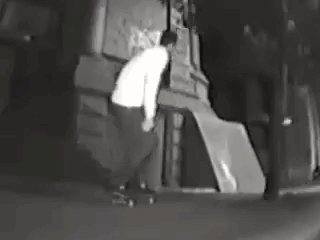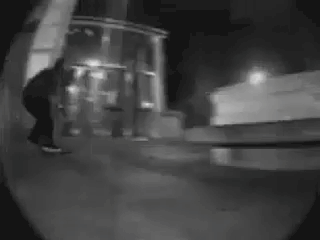Rules of Skateboarding #1: Bobby Puleo on Wallies
Illustration by Cosme Studio
There has never been a book of bylaws or standards that governs skateboarding, but let's be real – there are certain rules to it. Today we're launching a new monthly feature where Ian Browning digs in to these "rules" with experts on specific subjects within skating. This month he asked Bobby Puleo: "How do you feel about wallies?".
How do you feel about the prevalence of wallies in the past decade of skateboarding?
Man, a decade is a long time, but I mean, ultimately I don’t really care. It’s a personal choice, you know? I don't do them, but there's a reason why. You'd really have to kind of re-examine the history of wallies and wallrides throughout the years to kinda weigh in on them now.
Obviously there were wallrides, and then out of the wallride, at the same time developed the wallie. I would say 1985-'86. '87 being the real beginning of the wallride with Natas and Gonz and it trickling into the rest of the skate community. And then there was the stuff Tim Jackson did with the wallie a little later. Wallrides went out real quick by '88-'89. Watch Rubbish Heap and count how many wallrides are in that— yery few. Then really, I think the rebirth of the wallride in the early ‘90s was with that line that Rick Howard does—his last line in the Goldfish video which was in ‘93—he’s skating down Sunset or Hollywood Boulevard and he finishes his line and he goofs off and does a wallride and kinda falls out of it. Right after that video came out, you had this resurgence of wallrides and wallies I really attribute it to the Philly dudes running with it. Their terrain was ripe for it. Rick Oyola, in my opinion, was somebody who really re-birthed that thing. But obviously Matt Reason and Serge Trudnowski and a couple of the other dudes that were part of that crew of Philly guys helped re-birth it. Fred Gall, to a certain extent. Those guys were influencing Donny Barley, and Donny was influencing Jamie Thomas. That stuff all kind of died too after a few years, kinda by '98-'99. So there you have the second death.
Ricky Oyola, wallie as seen in Underachievers: Eastern Exposure 3, 1996.
Not to get off topic, but a lot of what makes a discussion like this possible is obviously the ability to examine and re-examine the evolution of skateboard tricks, but if you weren't there in the beginning of something to experience the zeitgeist of when it was happening, then you have no real context to base your choice to do something on nowadays. Then its all from this retro perspective. If you're even aware that these tricks were being done 30 years ago. A lot of kids start skating today and have no clue that a wallie is over 30 years old. So it gets tricky. From my perspective I saw the life and death of the wallride / wallie twice already.
From a point where it first started and then where it went out of style, you know, and that meant by doing it at a certain time period after the first time it went out of style you were ostracizing yourself. You were putting yourself into a category of antiquated or outdated tricks. And that was something that was always a part of skateboarding. You didn't want to do outdated tricks, you wanted to stay up because the tide was moving. As much as skateboarders, critics, journalists, or whoever is recording the timeline of skateboarding want to say that there are no rules, there always has been a wave. And you’re either in the front of the wave or behind the wave.
Natas Kaupas, wallie to grab as seen in Streets of Fire, 1989.
That’s a good way of putting it.
I mean, it’s true! We’re at a time period where if you have not been there, then you have no real context. You may have old videos and magazines, but to not experience the waves as they were happening essentially means that you don’t fully understand the history of something. And that's fine. You can’t blame somebody for whatever time period they’ve been born in. And I'm not saying don't do wallies or don't skate. But I guess what I am saying is that because of being around in those periods where the wallie went out is a large part of why I don't do them.
Matt Reason, 50-50 to wallie as seen in Dream Reality, 1997.
But again, I'm not necessarily saying don’t do wallrides or wallies. In this day and age alongside trick selection, which is a huge part of skateboarding, you kind of curate your aesthetic or whatever. Alongside that, just like I said, going back to popular tricks or whatever, you choose your arsenal of tricks to be presented. In my opinion the wallride or the wallie, in this day and age, it gets thrown around way too much. To me somebody bashing off a wall twenty times in a video part is not really that graceful or thoughtful. A wall is not a spot, per se. If you have a video part do one wallride on something really cool and leave it at that, you know? In my opinion, don’t do the wallride or wallie or pole jam and then do a switch back tailslide revert on the ledge down the street. You know what i’m saying?
In my opinion, the two tricks don’t mix. Wallies are an easy trick to be honest. You don’t really have to hit your tail. It’s like razor scootering. People razor scooter because it’s easy. And that's why the trick gets thrown around so much today. 'Cause they're easy.
The idea of riding on a wall, back then, especially from flat with no bank, it boggled my mind the first time I saw someone do it. At the time it was the tippy top of innovative street skating. But nowadays when you look back on it, to a certain extent, it’s just raw power to jam up it. There’s certain people like Dressen, or Natas or even Gonz, you go back to like 1987 and you watch them do it and it’s incredible and it’s graceful but it’s made for back then to a certain extent. That’s the reason why it developed way back then: because it was/is somewhat of an easy trick. Which is all good—there’s nothing wrong with doing easy tricks but that’s just the way I process the whole thing.
Guy Mariano, switch wallie 50-50 as seen in Mouse, 1997.
So you mentioned trick selection and combining tricks. I feel like we’ve seen a lot of people trying to take the wallie as an easy trick and repurpose aspects of it either by doing it switch or by doing it into a slide or a grind or something.
Yeah, it’s stupid. It’s dumb. I mean, at this point there’s no such thing as switch anymore because of the context which skating is learned these days. Kids learn how to skate regular and switch at the same time. So is that switch? Granted, it’s cool to find a wallie pole that is bent up to a wall or ledge or something. That’s well and great and that stuff should be documented. To a certain extent that’s it. Just leave it at that. Wallie into that whatever and then just leave it at that. Don’t now go and film that wallride down 20 stairs. You don’t need it in my opinion.
There’s also definitely a hesh edge to wallies or wallrides. It still has a very hesh aesthetic. It's a bit aggressive rather than tech savy. A great example though of complementing is Guy (Mariano) in Mouse. He does a switch wallie grind up that thick pole barrier thing by the bus stop, and that’s it, you know? Boom, done. It should be in his part. It’s cool, and it’s kind of a nod to a time period. Almost like Gonz would have done this. But Guy's not hesh. Guy was there for the wallride thing the first time around. You know? He should be able to do and film stuff like that.
In my opinion, people should have better filters on the things they film. That's I guess is if we're talking about filming wallies. It’s rad when you see Guy do a switch wallie grind and then he doesn’t ever do one again. That’s great curating. It’s a great filter and it says a lot. He doesn’t play himself out, and that’s part of being a professional to a certain extent. Obviously there will always be a lot professionals that play themselves out with certain tricks. I guess what I'm saying is don't over do it. Don't play shit out.





